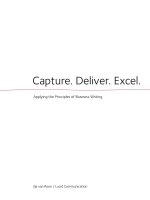Business finance ch 1 introduction
Bạn đang xem bản rút gọn của tài liệu. Xem và tải ngay bản đầy đủ của tài liệu tại đây (93.25 KB, 17 trang )
CHAPTER 1
An Overview of Financial
Management
Career Opportunities
Issues of the New Millennium
Forms of Businesses
Goals of the Corporation
Agency Relationships
1-1
Career Opportunities in
Finance
Money and capital markets
Investments
Financial management
1-2
Responsibility of the
Financial Staf
Maximize stock value by:
Forecasting and planning
Investment and financing decisions
Coordination and control
Transactions in the financial markets
Managing risk
1-3
Role of Finance in a Typical
Business Organization
Board of Directors
President
VP: Sales
VP: Finance
Treasurer
VP: Operations
Controller
Credit Manager
Cost Accounting
Inventory Manager
Financial Accounting
Capital Budgeting Director
Tax Department
1-4
Financial Management
Issues of the New
Millennium
The efect of
changing
technology
The
globalization of
business
1-5
Percentage of Revenue and Net
Income from Overseas Operations
for 10 Well-Known Corporations,
2001
Company
% of Revenue
from overseas
% of Net Income
from overseas
Coca-Cola
60.8
35.9
Exxon Mobil
69.4
60.2
General Electric
32.6
25.2
General Motors
26.1
60.6
IBM
57.9
48.4
JP Morgan Chase &
Co.
35.5
51.7
McDonald’s
63.1
61.7
Merck
18.3
58.1
3M
52.9
47.0
Sears, Roebuck
10.5
7.8
1-6
Alternative Forms of
Business Organization
Sole proprietorship
Partnership
Corporation
1-7
Sole proprietorships &
Partnerships
Advantages
Ease of formation
Subject to few regulations
No corporate income taxes
Disadvantages
Difficult to raise capital
Unlimited liability
Limited life
1-8
Corporation
Advantages
Unlimited life
Easy transfer of ownership
Limited liability
Ease of raising capital
Disadvantages
Double taxation
Cost of set-up and report filing
1-9
Financial Goals of the
Corporation
The primary financial goal is
shareholder wealth maximization,
which translates to maximizing
stock price.
Do firms have any responsibilities to
society at large?
Is stock price maximization good or
bad for society?
Should firms behave ethically?
1-10
Is stock price maximization
the same as profit
maximization?
No, despite a generally high
correlation amongst stock price, EPS,
and cash flow.
Current stock price relies upon current
earnings, as well as future earnings
and cash flow.
Some actions may cause an increase
in earnings, yet cause the stock price
to decrease (and vice versa).
1-11
Agency relationships
An agency relationship exists
whenever a principal hires an
agent to act on their behalf.
Within a corporation, agency
relationships exist between:
Shareholders and managers
Shareholders and creditors
1-12
Shareholders versus
Managers
Managers are naturally inclined to
act in their own best interests.
But the following factors afect
managerial behavior:
Managerial compensation plans
Direct intervention by shareholders
The threat of firing
The threat of takeover
1-13
Shareholders versus
Creditors
Shareholders (through managers)
could take actions to maximize
stock price that are detrimental to
creditors.
In the long run, such actions will
raise the cost of debt and
ultimately lower stock price.
1-14
Factors that afect stock
price
Projected cash
flows to
shareholders
Timing of the
cash flow stream
Riskiness of the
cash flows
1-15
Basic Valuation Model
CF1
CF2
CFn
Value
1
2
(1 k)
(1 k)
(1 k)n
n
CFt
.
t
t 1 (1 k)
To estimate an asset’s value, one estimates the
cash flow for each period t (CF t), the life of the
asset (n), and the appropriate discount rate (k)
Throughout the course, we discuss how to
estimate the inputs and how financial
management is used to improve them and thus
maximize a firm’s value.
1-16
Factors that Afect the
Level and Riskiness of
Cash Flows
Decisions made by financial
managers:
Investment decisions
Financing decisions (the relative use
of debt financing)
Dividend policy decisions
The external environment
1-17









